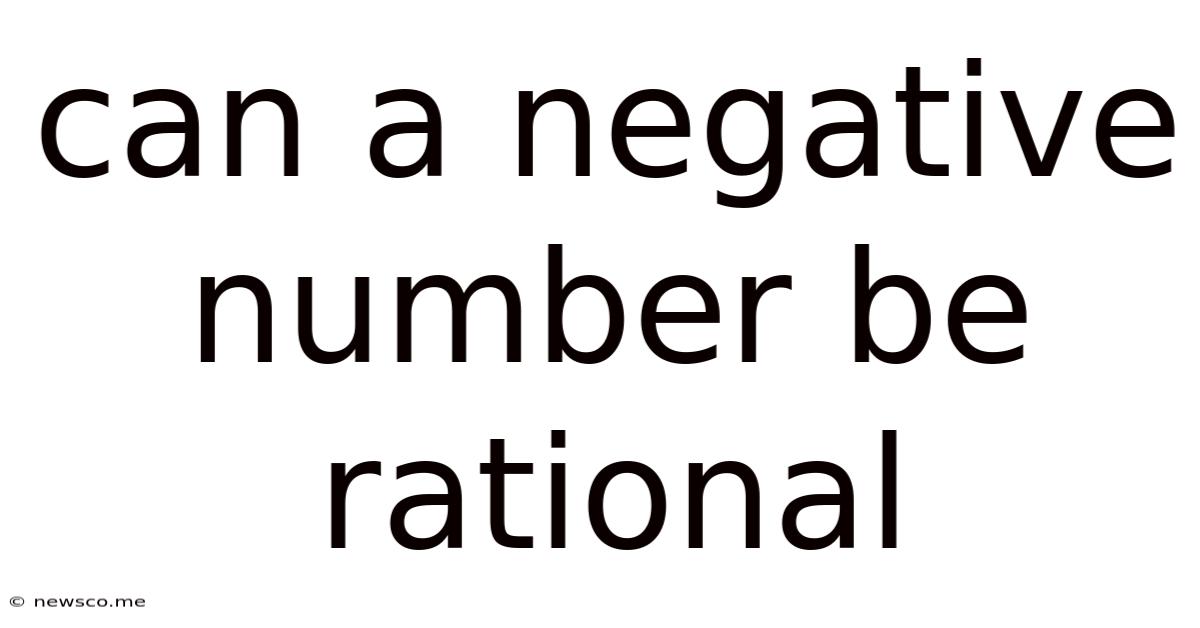Can A Negative Number Be Rational
News Co
Apr 08, 2025 · 4 min read

Table of Contents
Can a Negative Number Be Rational? Exploring the Realm of Rational Numbers
The question of whether a negative number can be rational is a fundamental concept in mathematics, often encountered early in one's mathematical journey. While seemingly simple, understanding this concept thoroughly involves grasping the definition of rational numbers and their relationship to integers, fractions, and the number line. This comprehensive article will delve into the intricacies of rational numbers, explore the properties of negative numbers, and definitively answer whether a negative number can indeed be rational. We'll also explore related concepts and provide examples to solidify understanding.
Understanding Rational Numbers
Before diving into the specifics of negative rational numbers, let's establish a firm understanding of what constitutes a rational number. A rational number is any number that can be expressed as a fraction p/q, where:
- p and q are integers (whole numbers, including zero and negative numbers).
- q is not equal to zero (division by zero is undefined).
This seemingly simple definition encapsulates a vast range of numbers. It includes:
- Integers: All whole numbers, both positive and negative, are rational. For example, -3 can be expressed as -3/1, 0 as 0/1, and 5 as 5/1.
- Fractions: These are the most obvious examples of rational numbers. 1/2, 3/4, -2/5, and 7/8 are all rational numbers.
- Terminating Decimals: Decimals that end after a finite number of digits are rational. For example, 0.75 (which is 3/4) and -0.25 (which is -1/4) are rational.
- Repeating Decimals: Decimals that have a repeating pattern of digits are also rational. For example, 0.333... (which is 1/3) and -0.142857142857... (which is -1/7) are rational.
The Role of Negative Numbers
Negative numbers represent values less than zero. They extend the number line to encompass values in the opposite direction of positive numbers. Their inclusion significantly expands the scope of mathematical operations and problem-solving. They are crucial for representing concepts like debt, temperature below zero, and changes in elevation.
Negative numbers are crucial in the context of rational numbers because they are allowed in both the numerator (p) and the denominator (q) of the fractional representation p/q. This opens up the possibility of negative rational numbers.
Can a Negative Number Be Rational? A Definitive Yes!
The answer to the central question is a resounding yes. A negative number can absolutely be a rational number. This is because the definition of a rational number explicitly allows for negative integers in both the numerator and the denominator.
Consider these examples:
- -3/1: This is a rational number, equivalent to the integer -3.
- -2/5: This is a rational number representing a negative fraction.
- -0.75: This terminating decimal is also a rational number, equivalent to -3/4.
- -1/7: This is a rational number represented by a negative repeating decimal.
Exploring Negative Rational Numbers Further
Let's delve deeper into some key aspects of negative rational numbers:
1. Representation on the Number Line:
Negative rational numbers are located on the left side of zero on the number line, just like negative integers. Their position reflects their value, with numbers further to the left representing smaller values.
2. Arithmetic Operations:
All standard arithmetic operations (addition, subtraction, multiplication, and division) can be performed on negative rational numbers, following the standard rules of arithmetic with signed numbers. For instance:
- (-1/2) + (1/4) = -1/4
- (-2/3) * (3/4) = -1/2
- (-5/6) / (-1/3) = 5/2
3. Comparing Negative Rational Numbers:
Comparing negative rational numbers involves considering their magnitude and sign. A negative rational number with a larger magnitude (further from zero) is considered smaller. For example: -3/4 < -1/2.
Distinguishing Rational from Irrational Numbers
It's crucial to understand the difference between rational and irrational numbers. While rational numbers can be expressed as a fraction of integers, irrational numbers cannot. Irrational numbers include numbers like π (pi) and √2 (the square root of 2). These numbers have decimal representations that neither terminate nor repeat. They exist on the number line but cannot be represented as a simple fraction.
The existence of negative irrational numbers underscores the distinction: -√2 is irrational, even though it's negative.
Practical Applications of Negative Rational Numbers
Negative rational numbers have widespread applications in various fields:
- Finance: Representing debts, losses, or negative balances in accounts.
- Science: Representing negative temperatures, negative velocities, or negative charges.
- Engineering: Representing negative forces, negative pressures, or negative displacements.
- Computer Science: Representing negative integers or fractions in computer programs.
The ability to represent and manipulate negative rational numbers is fundamental to accurately model and solve problems in these diverse fields.
Conclusion: A Comprehensive Understanding
This exploration comprehensively demonstrates that a negative number can indeed be rational. The definition of rational numbers explicitly accommodates negative integers, allowing for a wide range of negative numbers to be classified as rational. Understanding this fundamental concept is crucial for a firm grasp of mathematical principles and their practical applications across numerous disciplines. Whether expressed as fractions, terminating or repeating decimals, negative numbers seamlessly integrate into the realm of rational numbers, enriching the mathematical landscape and expanding the possibilities for problem-solving and real-world modeling. Remember, the key lies in the ability to express the number as a fraction p/q, where p and q are integers and q is not zero – regardless of the sign.
Latest Posts
Related Post
Thank you for visiting our website which covers about Can A Negative Number Be Rational . We hope the information provided has been useful to you. Feel free to contact us if you have any questions or need further assistance. See you next time and don't miss to bookmark.